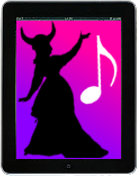One annoyance of reading scanned music on a tablet with a PDF app is that often the page numbers displayed on the app don’t match the page numbers printed in the score. The app always starts numbering with page 1, whereas the scanned version of the printed score may have a cover and several pages of front matter before getting to page 1. This issue occurs in both music-specific apps like forScore and general-purpose PDF reader apps, and it’s a pain to find the right page if, for example, a choral conductor is calling out page numbers during a rehearsal.
The PDF file format has a feature for assigning custom page numbers to pages, which I think could solve this problem. The feature is known as “logical page numbering,” and this link describes what it is and how to set up custom page numbers for a PDF document in Adobe Acrobat: PDF Files – Getting The Page Numbers Right. It lets you use lowercase Roman numerals for numbers, start with a page number other than 1, combine different numbering schemes within the same document, and more. Many PDF e-books already use this feature.
The catch is that, in order to make use of it, the PDF reader software must support the display of logical page numbers. I was curious about whether forScore does, so I created custom page numbers in one of my scores and then imported it into forScore. Unfortunately, it didn’t work – forScore still displayed the pages numbers starting with 1. I tried the same test with two other PDF music apps (unrealBook and MusicReader) and two other general-purpose PDF readers (Adobe Reader and iAnnotate PDF) with the same disappointing results. In fact, the only PDF reader app for iPad that I’m aware of that supports the display of logical page numbers is GoodReader, as documented in its manual.
I’ve sent a feature request to the forScore support team to ask them to support the display of logical page numbers. I’ll post an update if I hear back from them about it.
In the meantime, one way to deal with mismatched page numbers is to delete and/or move all of the front matter to the end of the PDF file so that your document really does start with page 1. You can even do this within forScore by using the Rearrange feature to re-order the pages. [UPDATE 11/9/12: @Lorskyfink contributes another workaround: if the printed page numbers are too high, add enough blank pages to the beginning of the score so that the page numbers displayed by the app match the printed page numbers.]
Related Posts:
- App review of ezPDF Reader for music reading on Android tablets [via Tech in Music Ed]
- Video: forScore Tutorial: Hands-free repeats, codas, and cuts with Rearrange
- BIG NEWS! MobileSheets PDF music reader for Android now supports annotation
- How to remove bindings from thick music scores for scanning
- Portable scanning of scores & reference materials: smartphones, iPad, scanners
- More posts tagged “sheet music”
- More posts tagged “scanning”










